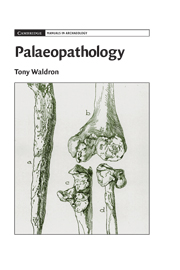Book contents
- Frontmatter
- Contents
- List of Figures
- Preface
- 1 Introduction and Diagnosis
- 2 Bone Metabolism and Pathology
- 3 Diseases of Joints, Part 1
- 4 Diseases of Joints, Part 2
- 5 Bone forming and DISH
- 6 Infectious Diseases
- 7 Metabolic Diseases
- 8 Trauma
- 9 Tumours
- 10 Disorders of Growth and Development
- 11 Soft Tissue Diseases
- 12 Dental Disease
- 13 An Introduction to Epidemiology
- Select Bibliography
- Index
- References
5 - Bone forming and DISH
Published online by Cambridge University Press: 05 June 2012
- Frontmatter
- Contents
- List of Figures
- Preface
- 1 Introduction and Diagnosis
- 2 Bone Metabolism and Pathology
- 3 Diseases of Joints, Part 1
- 4 Diseases of Joints, Part 2
- 5 Bone forming and DISH
- 6 Infectious Diseases
- 7 Metabolic Diseases
- 8 Trauma
- 9 Tumours
- 10 Disorders of Growth and Development
- 11 Soft Tissue Diseases
- 12 Dental Disease
- 13 An Introduction to Epidemiology
- Select Bibliography
- Index
- References
Summary
BONE FORMING AND BONE FORMERS
Within any skeletal assemblage there seems to be a proportion who apparently had a tendency to ossify soft tissues, especially the entheses, that is, the point at which tendons insert into bone, probably in response to minimal repetitive trauma. The result is the production of bony spurs at these points, which are referred to as enthesophytes. We alluded to these individuals as bone formers but our original definition was later modified by Rogers and her colleagues. Rogers and colleagues examined the sites of a series of entheses in the skeleton (fourteen in total) to see which showed the presence of an enthesophyte. The total number of enthesophytes was then divided by the number of sites examined and if the score was equal to, or greater than 0.3, that was considered evidence of bone forming. Bone formers are probably more likely than others to produce heterotopic ossification and to calcify or ossify costal cartilages, the thyroid cartilage and other soft tissues. It is not certain what proportion of the population are bone formers but it may be up to a fifth. There are several skeletal diseases in which bone forming is a feature – some joint diseases, some infections and Paget's disease, for example – and it is likely that the production of bone in these conditions will be particularly exuberant if the individual is also a bone former.
- Type
- Chapter
- Information
- Palaeopathology , pp. 72 - 82Publisher: Cambridge University PressPrint publication year: 2008



